Noise Reduction
In addition to typical random noise, CHRIS hyper-spectral images are affected by non-periodic partially deterministic disturbance patterns coming from the image formation process. The Noise Reduction Tool is used to correct and remove the coherent noises, known as drop-outs and vertical striping.
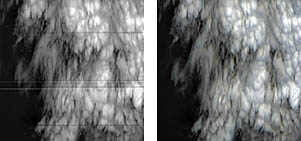
more...
Cloud Screening
The Cloud Screening Tool is used to mask cloudy pixels in CHRIS images. The cloud masking algorithm helps the user to find cloudy regions in the image and provides cloud probability and abundances for each pixel instead of a single flag. 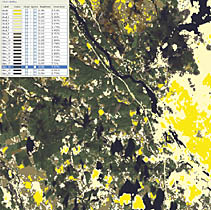 The method exploits the special characteristics of CHRIS, such as the high number of spectral bands, the spatial resolution, and the specific band locations. It evaluates the information coming from the spectral signature and from several specific features characterizing clouds in order to generate a probabilistic cloud mask, which indicates the cloud abundance per pixel. This can be converted into a binary cloud mask interactively. The method exploits the special characteristics of CHRIS, such as the high number of spectral bands, the spatial resolution, and the specific band locations. It evaluates the information coming from the spectral signature and from several specific features characterizing clouds in order to generate a probabilistic cloud mask, which indicates the cloud abundance per pixel. This can be converted into a binary cloud mask interactively.
more...
Atmospheric Correction
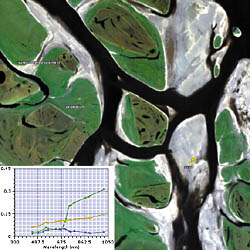 The CHRIS Atmospheric Correction Tool converts TOA radiance to surface reflec-tance images in an automated manner. The different steps to be performed along the atmospheric correction process depend on the CHRIS acquisition mode. The columnar water vapour (CWV) is only derived for CHRIS acquisition modes 1, 3 and 5, as no sufficient sampling of water vapour absorption features is provided by modes 2 and 4. On the other hand, spectral calibration and an optional spectral polishing are only performed on modes 1 and 5, which are the ones resolving most of the atmospheric absorption bands in the 400-1000 nm spectral range. The retrieval of aerosol optical thickness is part of the processing. The CHRIS Atmospheric Correction Tool converts TOA radiance to surface reflec-tance images in an automated manner. The different steps to be performed along the atmospheric correction process depend on the CHRIS acquisition mode. The columnar water vapour (CWV) is only derived for CHRIS acquisition modes 1, 3 and 5, as no sufficient sampling of water vapour absorption features is provided by modes 2 and 4. On the other hand, spectral calibration and an optional spectral polishing are only performed on modes 1 and 5, which are the ones resolving most of the atmospheric absorption bands in the 400-1000 nm spectral range. The retrieval of aerosol optical thickness is part of the processing.
more...
|
Geometric Correction
Many applications require the images to be geometrically referenced and/or rectified. In particular for those that make use of multi-angular information the geometric processing must be very accurate. CHRIS observation characteristics introduce strong perspective distortions, especially for the first and last images (with larger observation zenith angles). CHRIS images are delivered without geometric correction.
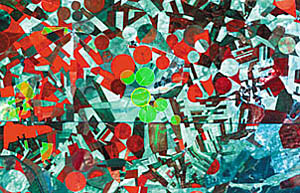
The geometric correction applied here is based on the parametric modelling of the acquisition process. It makes use of the satellite's position, velocity and pointing at the moment of line acquisition, projecting the line of sight onto the Earth's surface to calculate the geographical coordinate of each pixel. The coordinates map is then used for the rectification of the images. Note that the geometric correction is very inaccurate, when no ground control points (GCPs) are used to define the location for some pixels (image above). However, specifying several GCPs increases the accuracy significantly (image below). Though optional, the usage of GCPs is recommended.
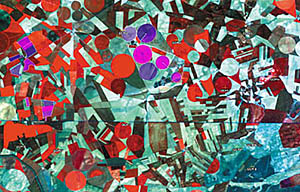
more...
|
BEAM Integration
BEAM is the ESA toolbox for visualisation, analysis and processing of optical Earth Observation data. A specific data reader has been developed to make CHRIS data fully available in BEAM. All image display functions are thus applicable to CHRIS data, including RGB, colour palettes, image zooming, panning, linking etc. Visual analysis functions include display of spectra, definition of regions of interests, masks, and statistical analysis of data.
Generic processing tools including band arithmectic, Level 3 spatio-temporal integration and mosaicking, reprojection and image collocation are available.
The open source BEAM software provides a well documented Application Programming Interface (API) in order to implement new processing algorithms for CHRIS.
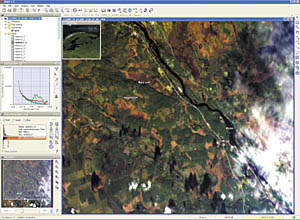
The four CHRIS tools (noise reduction, geometric correction, cloud screening and atmospheric correction, two examples are shown on the left) are implemented as BEAM processors. They come with their own graphical user interface, and can be called from the command line to allow batch processing.
The tools have been implemented as BEAM GPF modules and can be linked in Processing Graphs by configuration in an XML file.
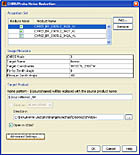 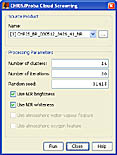
more...
|

